Occupational Therapy - Falls Assessment
VerifiedAdded on 2022/11/28
|6
|1607
|247
AI Summary
This study evaluates the health outcomes of older individuals and the effectiveness of restorative occupational therapy in reducing fall risk. It also explores the impact of interventions on home safety, fear of falling, and cost of care. Another study assesses the effectiveness of interventions in reducing fall risk in the elderly population. The article proposes the application of occupational therapy models to improve health literacy and outcomes. A randomized trial examines the efficiency of fall prevention interventions delivered by occupational therapists. Lastly, the relationship between occupation and falls is explored, highlighting the need for further research.
Contribute Materials
Your contribution can guide someone’s learning journey. Share your
documents today.
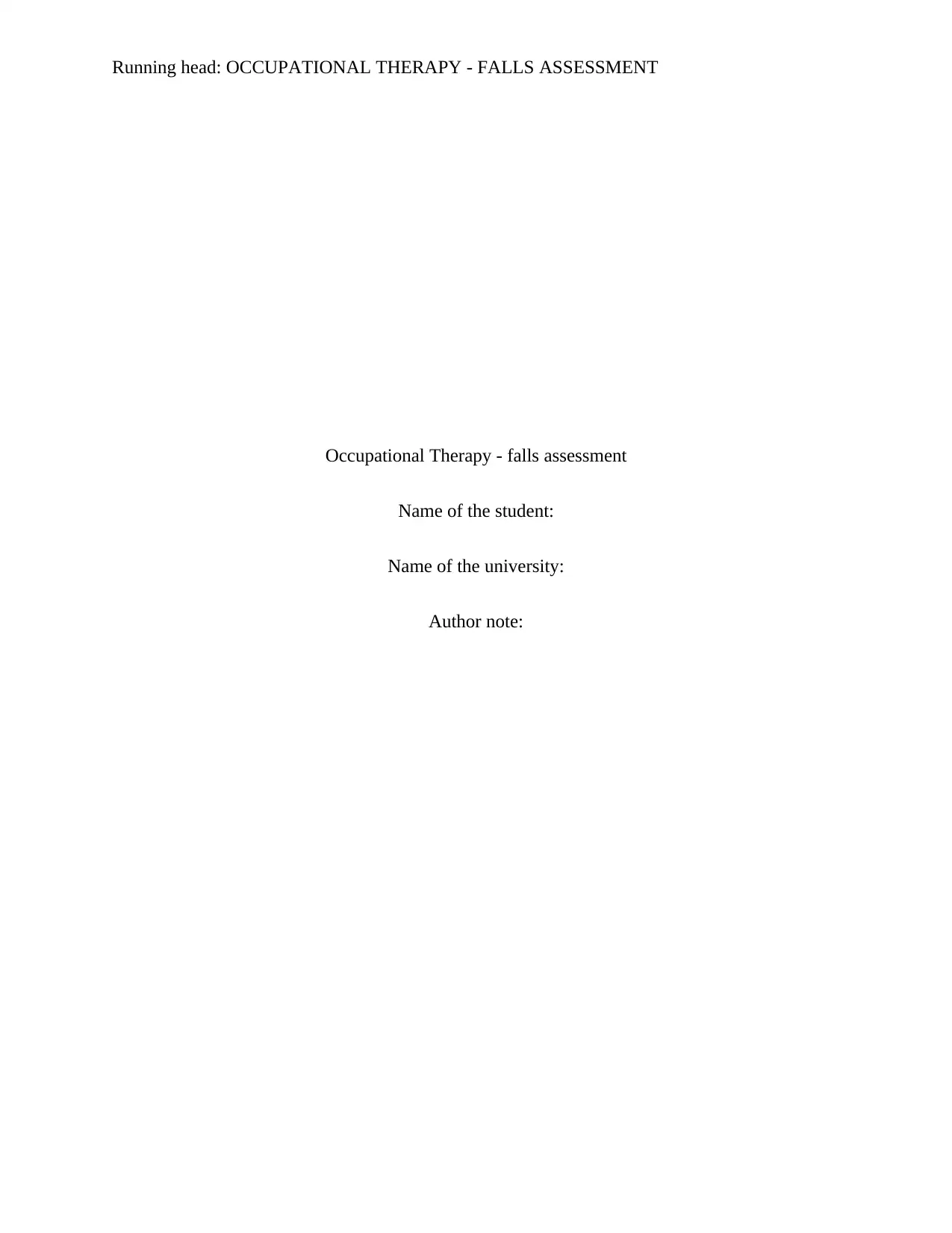
Running head: OCCUPATIONAL THERAPY - FALLS ASSESSMENT
Occupational Therapy - falls assessment
Name of the student:
Name of the university:
Author note:
Occupational Therapy - falls assessment
Name of the student:
Name of the university:
Author note:
Secure Best Marks with AI Grader
Need help grading? Try our AI Grader for instant feedback on your assignments.
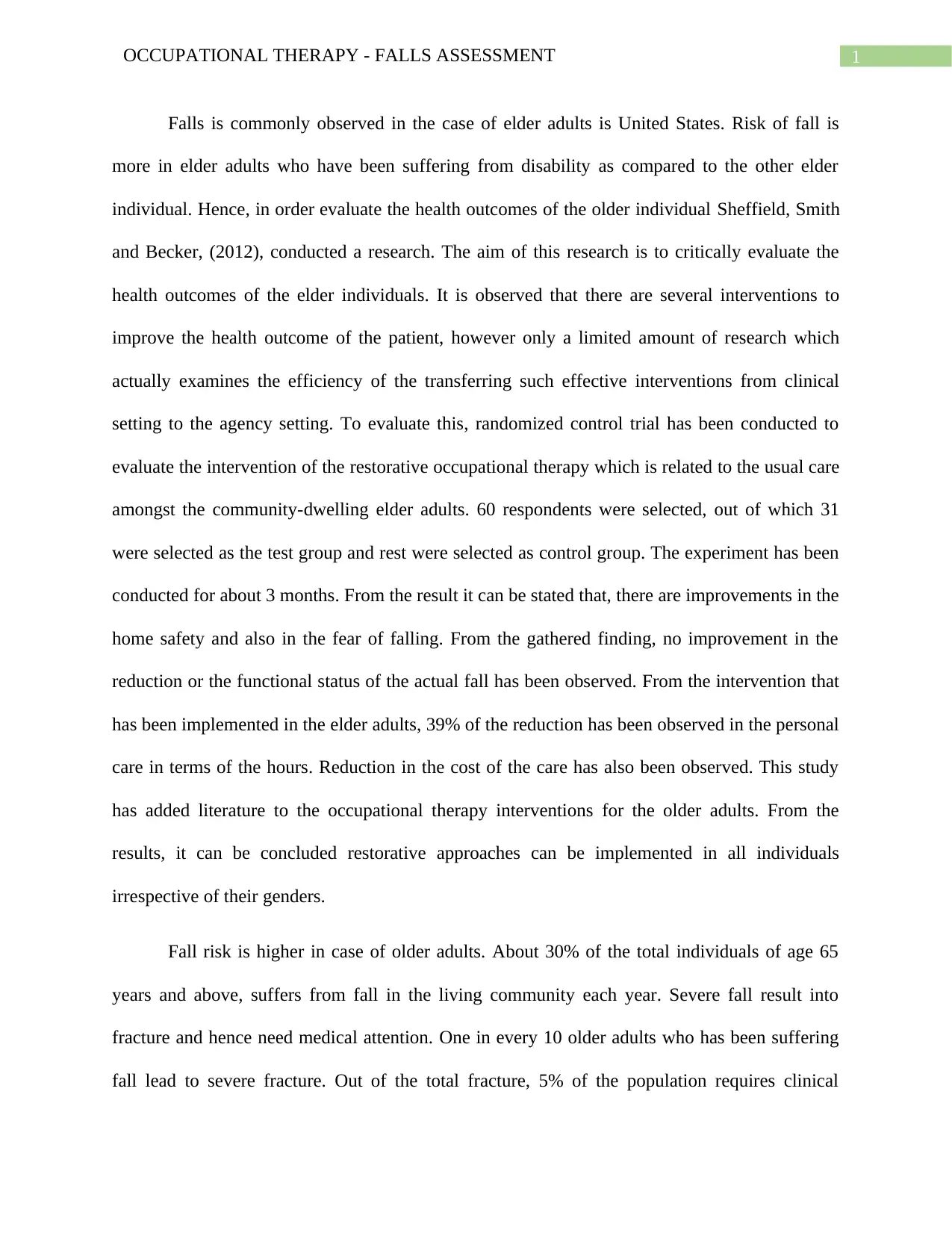
1OCCUPATIONAL THERAPY - FALLS ASSESSMENT
Falls is commonly observed in the case of elder adults is United States. Risk of fall is
more in elder adults who have been suffering from disability as compared to the other elder
individual. Hence, in order evaluate the health outcomes of the older individual Sheffield, Smith
and Becker, (2012), conducted a research. The aim of this research is to critically evaluate the
health outcomes of the elder individuals. It is observed that there are several interventions to
improve the health outcome of the patient, however only a limited amount of research which
actually examines the efficiency of the transferring such effective interventions from clinical
setting to the agency setting. To evaluate this, randomized control trial has been conducted to
evaluate the intervention of the restorative occupational therapy which is related to the usual care
amongst the community-dwelling elder adults. 60 respondents were selected, out of which 31
were selected as the test group and rest were selected as control group. The experiment has been
conducted for about 3 months. From the result it can be stated that, there are improvements in the
home safety and also in the fear of falling. From the gathered finding, no improvement in the
reduction or the functional status of the actual fall has been observed. From the intervention that
has been implemented in the elder adults, 39% of the reduction has been observed in the personal
care in terms of the hours. Reduction in the cost of the care has also been observed. This study
has added literature to the occupational therapy interventions for the older adults. From the
results, it can be concluded restorative approaches can be implemented in all individuals
irrespective of their genders.
Fall risk is higher in case of older adults. About 30% of the total individuals of age 65
years and above, suffers from fall in the living community each year. Severe fall result into
fracture and hence need medical attention. One in every 10 older adults who has been suffering
fall lead to severe fracture. Out of the total fracture, 5% of the population requires clinical
Falls is commonly observed in the case of elder adults is United States. Risk of fall is
more in elder adults who have been suffering from disability as compared to the other elder
individual. Hence, in order evaluate the health outcomes of the older individual Sheffield, Smith
and Becker, (2012), conducted a research. The aim of this research is to critically evaluate the
health outcomes of the elder individuals. It is observed that there are several interventions to
improve the health outcome of the patient, however only a limited amount of research which
actually examines the efficiency of the transferring such effective interventions from clinical
setting to the agency setting. To evaluate this, randomized control trial has been conducted to
evaluate the intervention of the restorative occupational therapy which is related to the usual care
amongst the community-dwelling elder adults. 60 respondents were selected, out of which 31
were selected as the test group and rest were selected as control group. The experiment has been
conducted for about 3 months. From the result it can be stated that, there are improvements in the
home safety and also in the fear of falling. From the gathered finding, no improvement in the
reduction or the functional status of the actual fall has been observed. From the intervention that
has been implemented in the elder adults, 39% of the reduction has been observed in the personal
care in terms of the hours. Reduction in the cost of the care has also been observed. This study
has added literature to the occupational therapy interventions for the older adults. From the
results, it can be concluded restorative approaches can be implemented in all individuals
irrespective of their genders.
Fall risk is higher in case of older adults. About 30% of the total individuals of age 65
years and above, suffers from fall in the living community each year. Severe fall result into
fracture and hence need medical attention. One in every 10 older adults who has been suffering
fall lead to severe fracture. Out of the total fracture, 5% of the population requires clinical
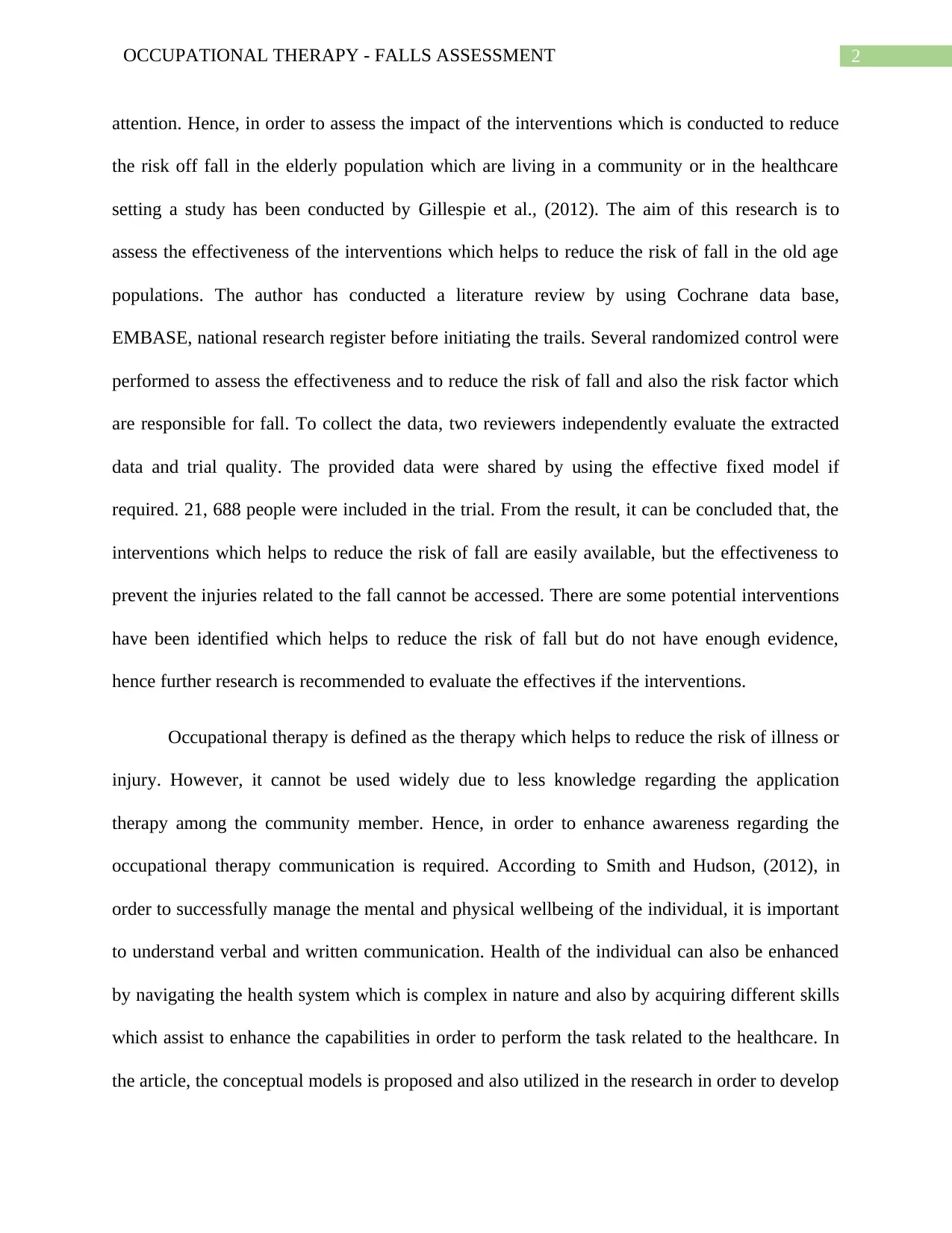
2OCCUPATIONAL THERAPY - FALLS ASSESSMENT
attention. Hence, in order to assess the impact of the interventions which is conducted to reduce
the risk off fall in the elderly population which are living in a community or in the healthcare
setting a study has been conducted by Gillespie et al., (2012). The aim of this research is to
assess the effectiveness of the interventions which helps to reduce the risk of fall in the old age
populations. The author has conducted a literature review by using Cochrane data base,
EMBASE, national research register before initiating the trails. Several randomized control were
performed to assess the effectiveness and to reduce the risk of fall and also the risk factor which
are responsible for fall. To collect the data, two reviewers independently evaluate the extracted
data and trial quality. The provided data were shared by using the effective fixed model if
required. 21, 688 people were included in the trial. From the result, it can be concluded that, the
interventions which helps to reduce the risk of fall are easily available, but the effectiveness to
prevent the injuries related to the fall cannot be accessed. There are some potential interventions
have been identified which helps to reduce the risk of fall but do not have enough evidence,
hence further research is recommended to evaluate the effectives if the interventions.
Occupational therapy is defined as the therapy which helps to reduce the risk of illness or
injury. However, it cannot be used widely due to less knowledge regarding the application
therapy among the community member. Hence, in order to enhance awareness regarding the
occupational therapy communication is required. According to Smith and Hudson, (2012), in
order to successfully manage the mental and physical wellbeing of the individual, it is important
to understand verbal and written communication. Health of the individual can also be enhanced
by navigating the health system which is complex in nature and also by acquiring different skills
which assist to enhance the capabilities in order to perform the task related to the healthcare. In
the article, the conceptual models is proposed and also utilized in the research in order to develop
attention. Hence, in order to assess the impact of the interventions which is conducted to reduce
the risk off fall in the elderly population which are living in a community or in the healthcare
setting a study has been conducted by Gillespie et al., (2012). The aim of this research is to
assess the effectiveness of the interventions which helps to reduce the risk of fall in the old age
populations. The author has conducted a literature review by using Cochrane data base,
EMBASE, national research register before initiating the trails. Several randomized control were
performed to assess the effectiveness and to reduce the risk of fall and also the risk factor which
are responsible for fall. To collect the data, two reviewers independently evaluate the extracted
data and trial quality. The provided data were shared by using the effective fixed model if
required. 21, 688 people were included in the trial. From the result, it can be concluded that, the
interventions which helps to reduce the risk of fall are easily available, but the effectiveness to
prevent the injuries related to the fall cannot be accessed. There are some potential interventions
have been identified which helps to reduce the risk of fall but do not have enough evidence,
hence further research is recommended to evaluate the effectives if the interventions.
Occupational therapy is defined as the therapy which helps to reduce the risk of illness or
injury. However, it cannot be used widely due to less knowledge regarding the application
therapy among the community member. Hence, in order to enhance awareness regarding the
occupational therapy communication is required. According to Smith and Hudson, (2012), in
order to successfully manage the mental and physical wellbeing of the individual, it is important
to understand verbal and written communication. Health of the individual can also be enhanced
by navigating the health system which is complex in nature and also by acquiring different skills
which assist to enhance the capabilities in order to perform the task related to the healthcare. In
the article, the conceptual models is proposed and also utilized in the research in order to develop
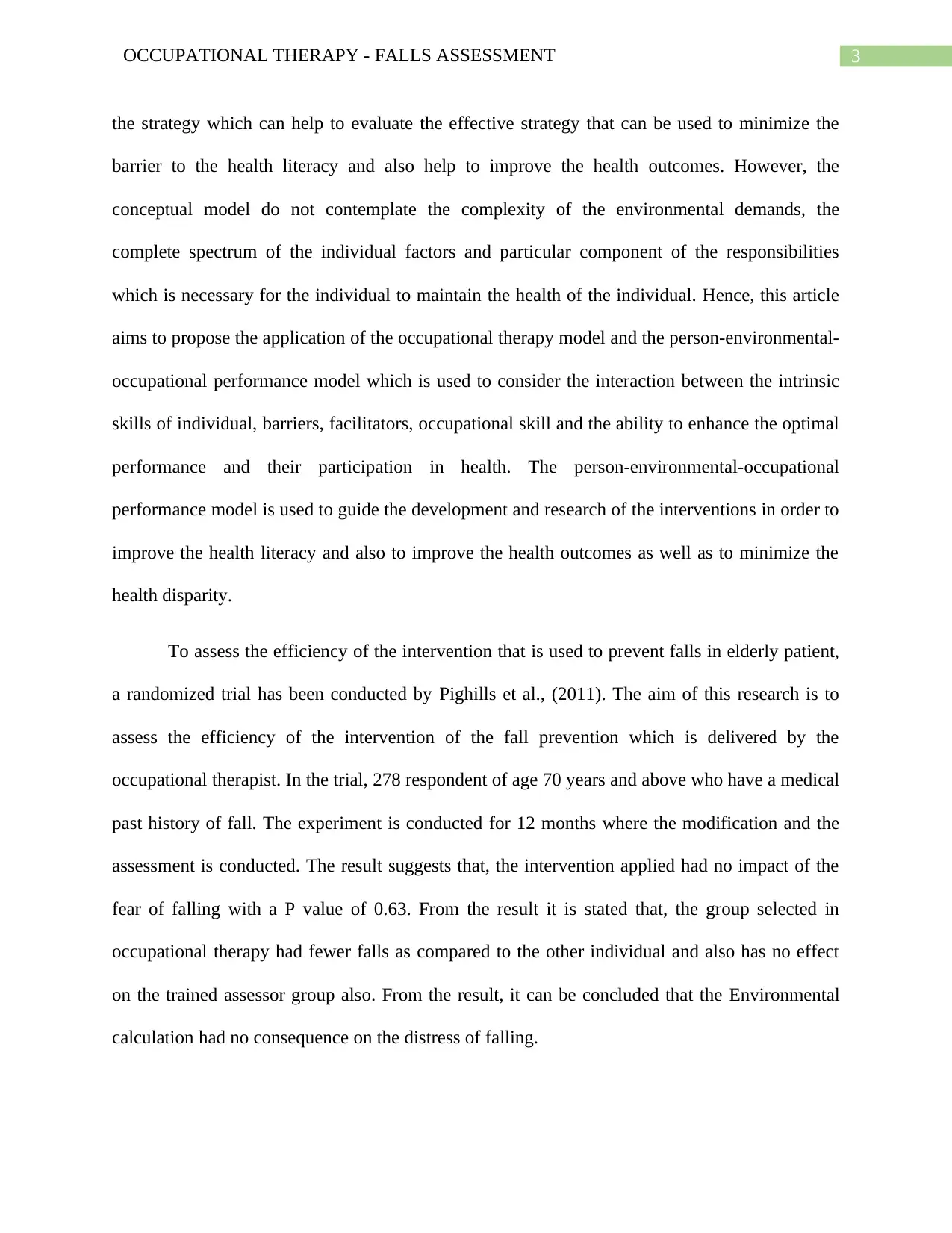
3OCCUPATIONAL THERAPY - FALLS ASSESSMENT
the strategy which can help to evaluate the effective strategy that can be used to minimize the
barrier to the health literacy and also help to improve the health outcomes. However, the
conceptual model do not contemplate the complexity of the environmental demands, the
complete spectrum of the individual factors and particular component of the responsibilities
which is necessary for the individual to maintain the health of the individual. Hence, this article
aims to propose the application of the occupational therapy model and the person-environmental-
occupational performance model which is used to consider the interaction between the intrinsic
skills of individual, barriers, facilitators, occupational skill and the ability to enhance the optimal
performance and their participation in health. The person-environmental-occupational
performance model is used to guide the development and research of the interventions in order to
improve the health literacy and also to improve the health outcomes as well as to minimize the
health disparity.
To assess the efficiency of the intervention that is used to prevent falls in elderly patient,
a randomized trial has been conducted by Pighills et al., (2011). The aim of this research is to
assess the efficiency of the intervention of the fall prevention which is delivered by the
occupational therapist. In the trial, 278 respondent of age 70 years and above who have a medical
past history of fall. The experiment is conducted for 12 months where the modification and the
assessment is conducted. The result suggests that, the intervention applied had no impact of the
fear of falling with a P value of 0.63. From the result it is stated that, the group selected in
occupational therapy had fewer falls as compared to the other individual and also has no effect
on the trained assessor group also. From the result, it can be concluded that the Environmental
calculation had no consequence on the distress of falling.
the strategy which can help to evaluate the effective strategy that can be used to minimize the
barrier to the health literacy and also help to improve the health outcomes. However, the
conceptual model do not contemplate the complexity of the environmental demands, the
complete spectrum of the individual factors and particular component of the responsibilities
which is necessary for the individual to maintain the health of the individual. Hence, this article
aims to propose the application of the occupational therapy model and the person-environmental-
occupational performance model which is used to consider the interaction between the intrinsic
skills of individual, barriers, facilitators, occupational skill and the ability to enhance the optimal
performance and their participation in health. The person-environmental-occupational
performance model is used to guide the development and research of the interventions in order to
improve the health literacy and also to improve the health outcomes as well as to minimize the
health disparity.
To assess the efficiency of the intervention that is used to prevent falls in elderly patient,
a randomized trial has been conducted by Pighills et al., (2011). The aim of this research is to
assess the efficiency of the intervention of the fall prevention which is delivered by the
occupational therapist. In the trial, 278 respondent of age 70 years and above who have a medical
past history of fall. The experiment is conducted for 12 months where the modification and the
assessment is conducted. The result suggests that, the intervention applied had no impact of the
fear of falling with a P value of 0.63. From the result it is stated that, the group selected in
occupational therapy had fewer falls as compared to the other individual and also has no effect
on the trained assessor group also. From the result, it can be concluded that the Environmental
calculation had no consequence on the distress of falling.
Secure Best Marks with AI Grader
Need help grading? Try our AI Grader for instant feedback on your assignments.
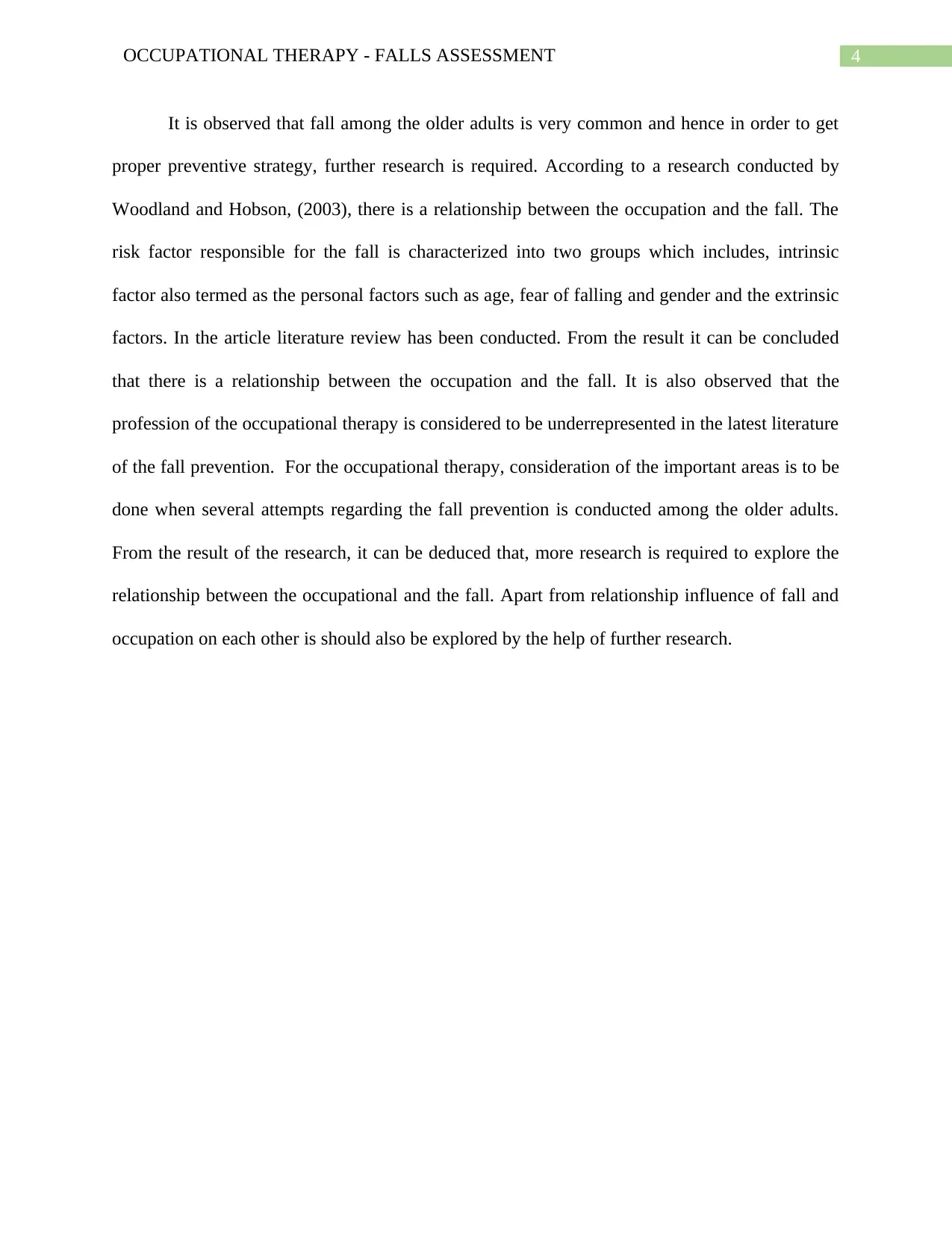
4OCCUPATIONAL THERAPY - FALLS ASSESSMENT
It is observed that fall among the older adults is very common and hence in order to get
proper preventive strategy, further research is required. According to a research conducted by
Woodland and Hobson, (2003), there is a relationship between the occupation and the fall. The
risk factor responsible for the fall is characterized into two groups which includes, intrinsic
factor also termed as the personal factors such as age, fear of falling and gender and the extrinsic
factors. In the article literature review has been conducted. From the result it can be concluded
that there is a relationship between the occupation and the fall. It is also observed that the
profession of the occupational therapy is considered to be underrepresented in the latest literature
of the fall prevention. For the occupational therapy, consideration of the important areas is to be
done when several attempts regarding the fall prevention is conducted among the older adults.
From the result of the research, it can be deduced that, more research is required to explore the
relationship between the occupational and the fall. Apart from relationship influence of fall and
occupation on each other is should also be explored by the help of further research.
It is observed that fall among the older adults is very common and hence in order to get
proper preventive strategy, further research is required. According to a research conducted by
Woodland and Hobson, (2003), there is a relationship between the occupation and the fall. The
risk factor responsible for the fall is characterized into two groups which includes, intrinsic
factor also termed as the personal factors such as age, fear of falling and gender and the extrinsic
factors. In the article literature review has been conducted. From the result it can be concluded
that there is a relationship between the occupation and the fall. It is also observed that the
profession of the occupational therapy is considered to be underrepresented in the latest literature
of the fall prevention. For the occupational therapy, consideration of the important areas is to be
done when several attempts regarding the fall prevention is conducted among the older adults.
From the result of the research, it can be deduced that, more research is required to explore the
relationship between the occupational and the fall. Apart from relationship influence of fall and
occupation on each other is should also be explored by the help of further research.
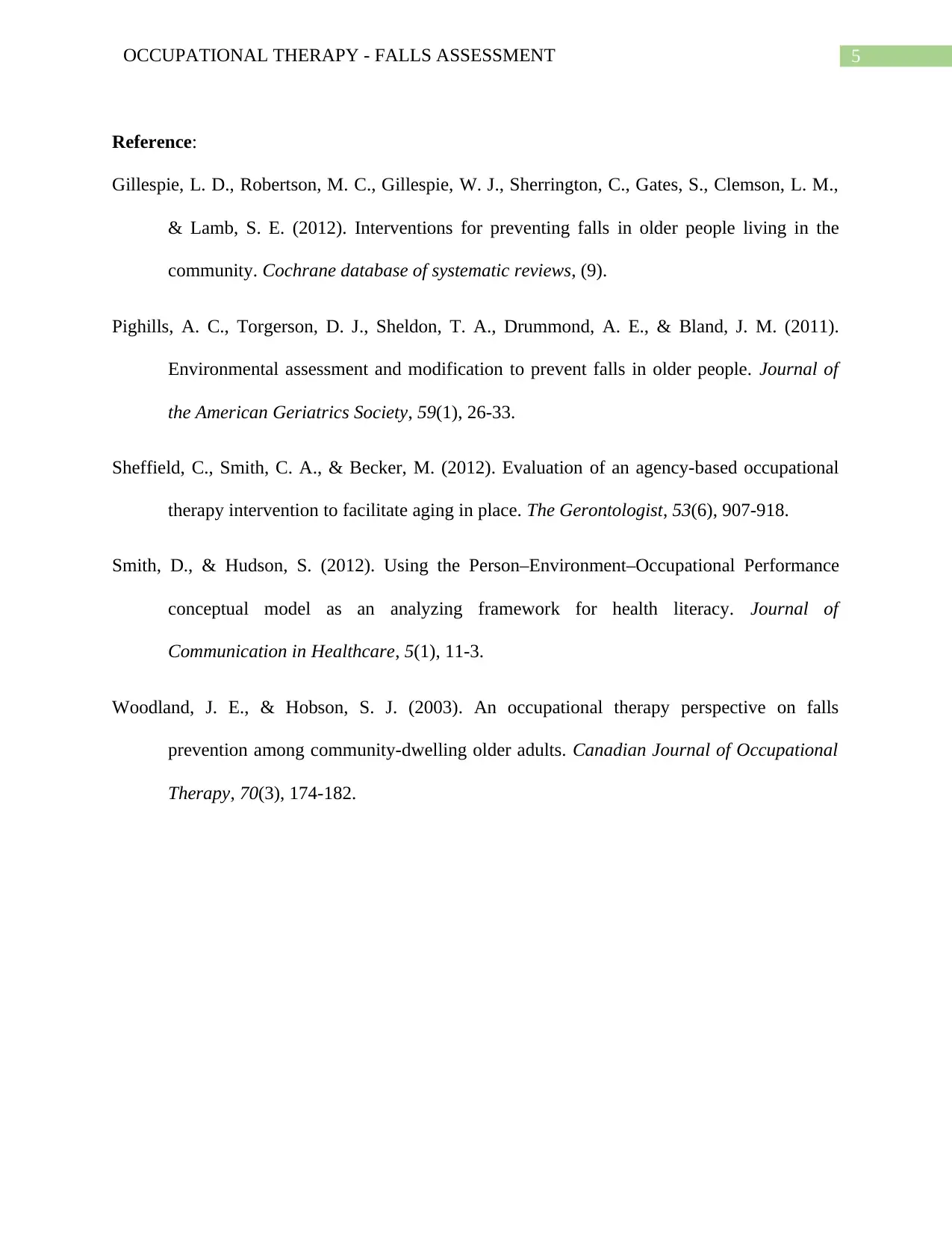
5OCCUPATIONAL THERAPY - FALLS ASSESSMENT
Reference:
Gillespie, L. D., Robertson, M. C., Gillespie, W. J., Sherrington, C., Gates, S., Clemson, L. M.,
& Lamb, S. E. (2012). Interventions for preventing falls in older people living in the
community. Cochrane database of systematic reviews, (9).
Pighills, A. C., Torgerson, D. J., Sheldon, T. A., Drummond, A. E., & Bland, J. M. (2011).
Environmental assessment and modification to prevent falls in older people. Journal of
the American Geriatrics Society, 59(1), 26-33.
Sheffield, C., Smith, C. A., & Becker, M. (2012). Evaluation of an agency-based occupational
therapy intervention to facilitate aging in place. The Gerontologist, 53(6), 907-918.
Smith, D., & Hudson, S. (2012). Using the Person–Environment–Occupational Performance
conceptual model as an analyzing framework for health literacy. Journal of
Communication in Healthcare, 5(1), 11-3.
Woodland, J. E., & Hobson, S. J. (2003). An occupational therapy perspective on falls
prevention among community-dwelling older adults. Canadian Journal of Occupational
Therapy, 70(3), 174-182.
Reference:
Gillespie, L. D., Robertson, M. C., Gillespie, W. J., Sherrington, C., Gates, S., Clemson, L. M.,
& Lamb, S. E. (2012). Interventions for preventing falls in older people living in the
community. Cochrane database of systematic reviews, (9).
Pighills, A. C., Torgerson, D. J., Sheldon, T. A., Drummond, A. E., & Bland, J. M. (2011).
Environmental assessment and modification to prevent falls in older people. Journal of
the American Geriatrics Society, 59(1), 26-33.
Sheffield, C., Smith, C. A., & Becker, M. (2012). Evaluation of an agency-based occupational
therapy intervention to facilitate aging in place. The Gerontologist, 53(6), 907-918.
Smith, D., & Hudson, S. (2012). Using the Person–Environment–Occupational Performance
conceptual model as an analyzing framework for health literacy. Journal of
Communication in Healthcare, 5(1), 11-3.
Woodland, J. E., & Hobson, S. J. (2003). An occupational therapy perspective on falls
prevention among community-dwelling older adults. Canadian Journal of Occupational
Therapy, 70(3), 174-182.
1 out of 6
Related Documents
Your All-in-One AI-Powered Toolkit for Academic Success.
+13062052269
info@desklib.com
Available 24*7 on WhatsApp / Email
![[object Object]](/_next/static/media/star-bottom.7253800d.svg)
Unlock your academic potential
© 2024 | Zucol Services PVT LTD | All rights reserved.





